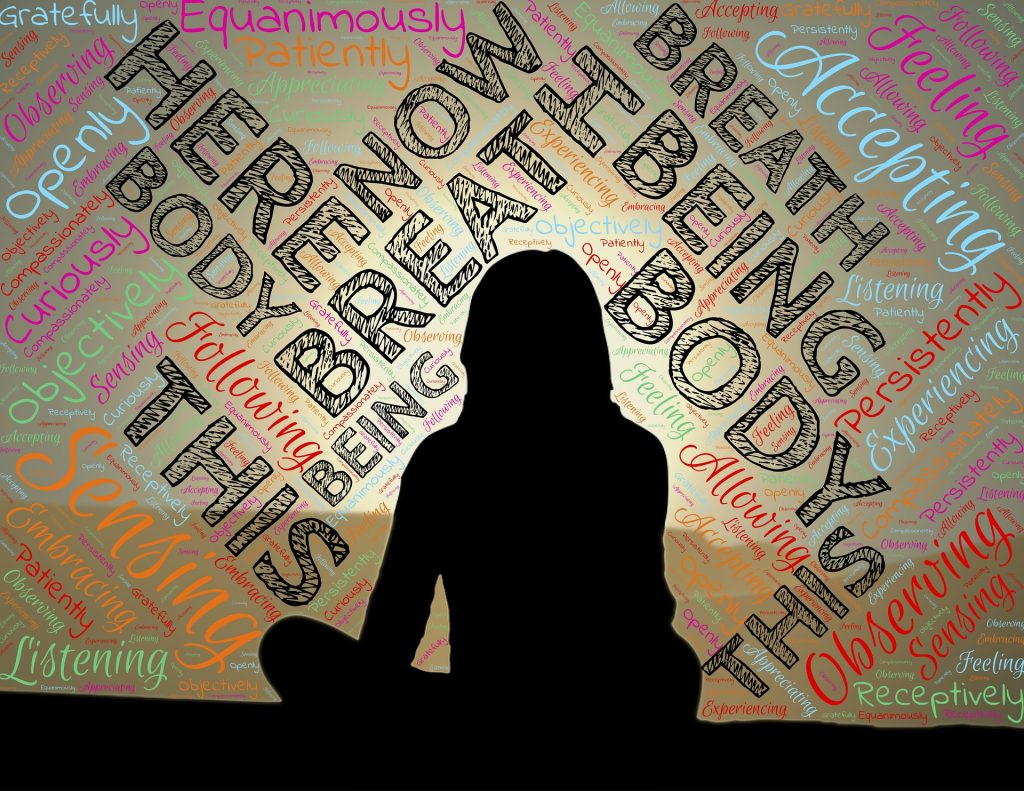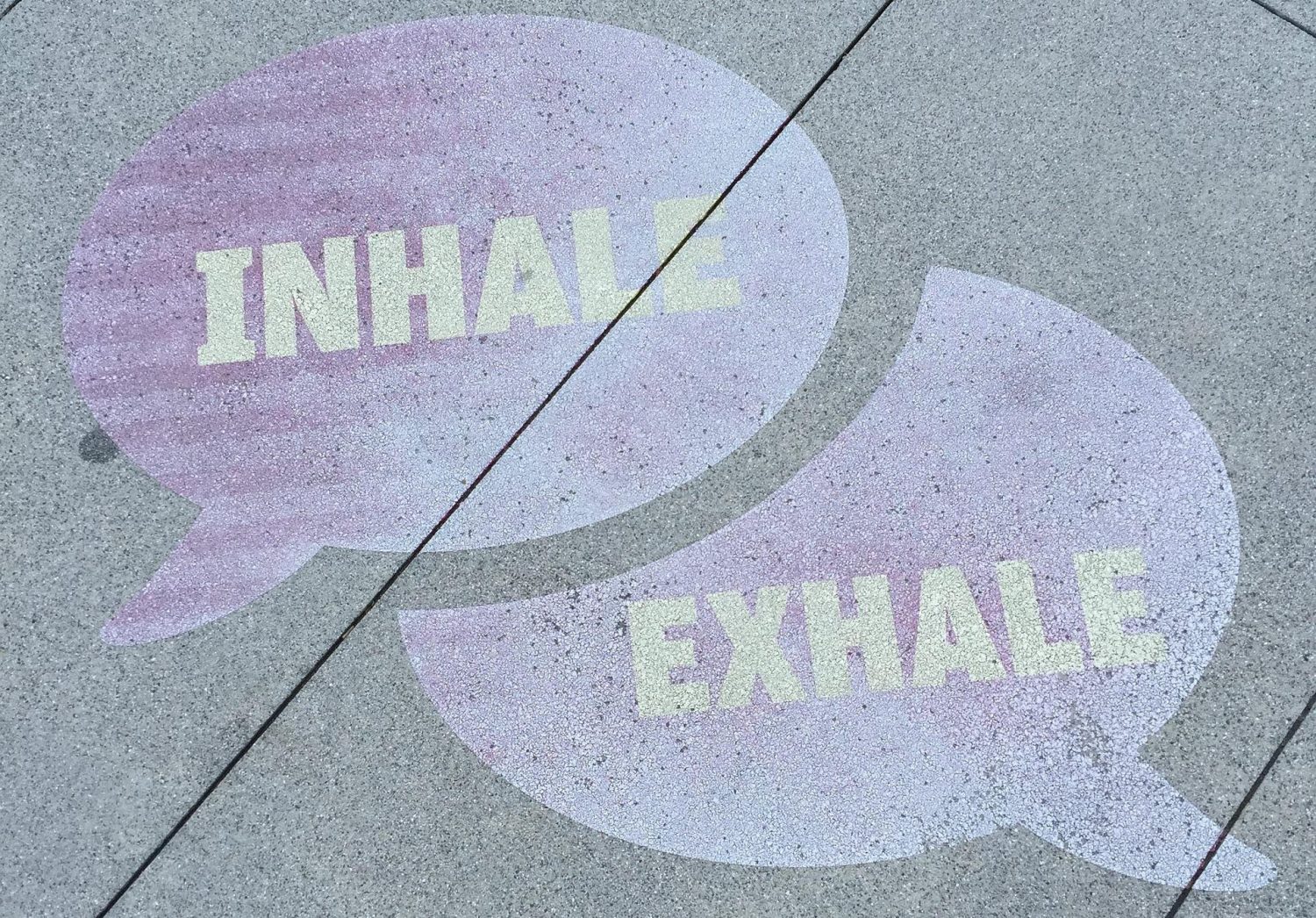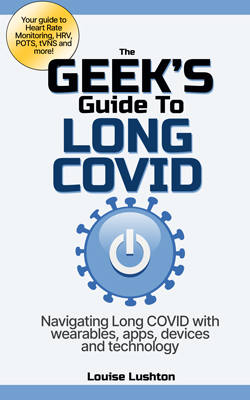Long Covid can cause shortness of breath, autonomic dysfunction and, unsurprisingly, a great deal of stress. One way to calm your nervous system and find a bit of peace is to undertake breathing exercises.
Even two or three long, deep breaths will slow the heart, increase oxygen intake and prompt a reduction in the “flight or fight” response (see Wikipedia). A 2021 study found deep breathing can improve HRV and vagal tone in older adults. Deep breathing has also been found to reduce stress, help with anxiety and PTSD, and even improve pulmonary function after heart surgery. This research review does a good job of summing up the various research into deep breathing.
Deep breathing, or diaphragmatic breathing, encourages you to focus your attention on your breathing, which is a form of meditation. This can calm your mind. While many of us breathe without thinking using our chest muscles, deep breathing typically requires a focus on the diaphragm muscle, which is located just under the rib cage. You are also encouraged to breathe through your nose. Some forms suggest breathing in through the nose and out through the mouth.
You can practice breathing through your diaphragm like this:
Advertisement
The Geek’s Guide To Long Covid is available as an ebook!
You’ll find a comprehensive guide to using wearables, apps and technology to cope with Long Covid. It offers detailed instructions on pacing, heart rate monitoring, HRV, POTS, deep breathing, tVNS, air purifiers, CO2 monitors and lots more.
Available from Amazon
- Sit in a comfortable chair or lay down in a comfortable position
- Place one hand just under your ribcage. This is where the diaphragm is located.
- Take a deep breath in using only the diaphragm muscle. Your hand should rise. You’ll feel your belly expand as the diaphragm extends downwards.
- Try not to use your chest muscles to breathe in.
- Exhale slowly through pursed lips. Repeat five times.
- Breathe normally for five breaths
- Repeat a few times.
A tip: Breathing with your diaphragm may feel uncomfortable if you have shortness of breath or if you aren’t used to breathing this way. If this is the case, don’t worry about it too much. Instead, take a deep breath how you normally would and do the deep breathing exercise that way. The same principle applies if you have difficulty breathing through your nose due to sinus or other issues. Just breathe through your mouth instead. Don’t let fear of an imperfect technique get in the way of the relaxing exercise that this is supposed to be. Just roll with it. And as you do more breathing exercises, it may become easier to breathe with the diaphragm.

Some Breathing Exercises
Resonance Breathing (4 in, 6 out)
The idea behind resonance breathing is to reduce the number of breaths to around 6 per minute. Put very simply, this aims to bring your breathing in line with your heartbeat and baroreflex (blood pressure system), inducing a state of “coherence” or “resonance”. This then lowers blood pressure and improves heart rate variability, which then improves your vagal tone and autonomic function. In theory, regular resonance breathing can help you to gain more conscious control over your body and calm yourself more easily. This is called “biofeedback” training. There’s a lot of research being done into the effectiveness of resonance breathing and we’re still learning about it (see studies here, here, and here). Studies have shown that resonance breathing can help with fibromyalgia, heart disease, asthma, and depression.
How To Do Resonance Breathing:
- Sit in a comfy chair or lay down.
- Take a few moments to settle and bring your focus to your breathing. Take a couple of big, deep breaths to help with this.
- Breathe in through your nose for a count of 4.
- Purse your lips and breathe out through your mouth for a count of 6.
- Repeat for 5, 10, 15 or 20 minutes, depending on how much time you have.
You can do your own biofeedback if you combine resonance breathing with HRV monitoring. You do this with the help of an app and wearable. For more info see below or visit the HRV page.
Box Breathing (4 in, 4 hold, 4 out, 4 hold)
Box breathing is also known as square breathing because it has a 4×4 pattern. The technique is said to be used by US Navy Seals as a calming technique and way to relieve stress in a high-tension environment. In yoga it is known as the sama vritti pranayama, part of the larger yogic practice of focusing on the breath. Box breathing is a way to “reset” your breathing to a normal rhythm during times of stress. If you are feeling like you’re in “fight or flight” mode, this method can shift the nervous system needle in a calmer direction.
According the Healthline, holding your breath during box breathing “allows CO2 to build up in the blood. An increased blood CO2 enhances the cardio-inhibitory response of the vagus nerve when you exhale and stimulates your parasympathetic system. This produces a calm and relaxed feeling in the mind and body.”
How To Do Box Breathing:
- Sit in a comfy chair or lay down.
- Take a few moments to settle and bring your focus to your breathing. Take a couple of big, deep breaths to help with this.
- Breathe in through your nose for a count of 4.
- Hold your breath for a count of 4.
- Purse your lips and breathe out through your mouth for a count of 4.
- Hold your breath for a count of 4.
- Repeat for as long as you need.
If you find it difficult to do the exercise with the full 4 counts, try 3 counts instead. Or if you wish to count for longer, go ahead. The main thing is to keep the breaths and holds of equal length.
Triangle Breathing (4 in, 4 hold, 4 out)
As the name suggests, triangle breathing is a method of breathing with 3 equal parts – inhale, hold and exhale. Again, the “hold” section means you retain some CO2 and ultimately get more oxygen into your blood. Triangle breathing is a good option for general relaxation.
How To Do Triangle Breathing:
- Sit in a comfy chair or lay down.
- Take a few moments to settle and bring your focus to your breathing. Take a couple of big, deep breaths to help with this.
- Breathe in through your nose for a count of 4
- Hold your breath for a count of 4.
- Purse your lips and breathe slowly out through your mouth for a count of 4.
- Repeat for as long as you need.
As you become more practiced you can increase the hold and exhale times, meaning the triangle ratio would be 4-8-8.
4-7-8 Technique (4 in, 7 hold, 8 out)
This is a breathing exercise designed by Harvard-trained integrative doctor Dr. Andrew Weil, based on yogic pranayama breathing. A 2022 study found that this type of breathing exercise can improve heart rate variability and blood pressure, especially in those who are sleep deprived. Like box breathing, this technique requires you to hold your breath; in this case for a fairly long period of time. It helps regulate blood CO2 levels. This exercise is recommended for deep relaxation, of if you are trying to fall asleep.
How To Do 4-7-8 Breathing:
- Sit in a comfy chair or lay down.
- Take a few moments to settle and bring your focus to your breathing. Take a couple of big, deep breaths to help with this.
- Exhale quickly through your mouth to empty your lungs.
- Breathe in through your nose for a count of 4.
- Hold your breath for a count of 7.
- Purse your lips and breathe slowly out through your mouth for a count of 8.
- Repeat the 4-7-8 cycle 4 times.
This breathing exercise may be difficult if you have shortness of breath or are trying it for the first time. Don’t push it if it makes you uncomfortable. Don’t perform the exercise more than 4 times unless you’ve practiced it and feel ready to do so.
Alternate Nostril Techniques
Alternate nostril breathing has long been part of the yoga breathing (pranayama) tradition. It’s a relatively simple method that helps you to focus on the breath and slow down your breathing. A 2017 review of various studies found that there was evidence this type of breathing improved cardiopulmonary and autonomic nervous function. It also found evidence for improved cognitive functioning.
There are two types of alternate nostril breathing:
Anulom vilom – switching between the nostrils with each inhale and exhale
Nadi shodhana – switching between the nostrils with each inhale but holding the breath before exhale.
How To Do Alternate Nostril Breathing
- Sit in a comfy chair or lay down.
- Take a few moments to settle and bring your focus to your breathing. Take a couple of big, deep breaths to help with this.
- Bring your hand to your face, place the index and middle finger on your forehead. If you are right handed your thumb will rest against the right nostril, your ring finger against the left nostril.
- Using your thumb, close the right nostril. Take a deep breath in with your left nostril.
- If you are using the Nadi shodhana method, hold your breath for a few moments.
- Close the left nostril with your ring finger and breath out with your right nostril.
- Breathe in again through your right nostril.
- Repeat the process for as long as you need.
Sighing
If you are prone to hyperventilation, anxiety or have body-related trauma, the above breathing exercises may not be ideal. Focusing on the body may cause more anxiety or self-judgement, making you more worried about getting the exercise right, rather than relaxing. In this scenario, a good alternative is simply sighing. Taking a short breath in and exhaling quickly with a sigh will still help to slow your heart and initiate some calm.
Biofeedback and Resonance Apps
You can combined deep breathing exercises with wearables and apps to conduct your own biofeedback experiments. If you’re interested in resonance breathing to improve autonomic function, you can fine tune the process to your own bodily rhythms through biofeedback. Typically this involves a lot of trial and error to see what breathing ratio works best. For some it might be inhale for a count of 5.5, exhale for a count of 7. It really depends on the individual.
Elite HRV has a selection of deep breathing biofeedback programs within the free app (though you need a Polar H10 chest strap to use the app). These include resonance, deep calm, ease anxiety, box breathing, balanced and several breathing stimulation exercises. These exercises have pre-set paces but you’re able to set the inhale, exhale and hold length for each one to whatever ratio/intervals you prefer. You can set the amount of time taken to do each exercise e.g. 10 minutes. A voice tells you to breathe in and out and a visual prompt also indicates when to inhale and exhale. A running graph keeps track of your heart rate and HRV scores throughout the exercise so you can see what works and what doesn’t. Tweaking the breathing ratios allows you to see what works best for your own body.
The video above gives a comprehensive guide to using Elite HRV to find your ideal format of resonance breathing.
HRV4Biofeedback is an app run by HRV tracker company HRV4Training. This app measures your HRV with the phone camera so you don’t need to spend extra money on a wearable to use it. You put your finger over the phone camera while you do the breathing exercises and it tracks your heart rate and HRV. The basic breath exercise is resonant breathing, 6 breaths per minute, but you can adjust the ratio. The app also offers a test to find what is the best ratio/frequency for your individual needs. The app isn’t free, you need to pay a one-off fee. You can bundle it with several other HRV4Training apps which may be worth pursuing. Apple only. The app keeps some data.
Resonant Breathing App is a very simple free app that offers guided resonance breathing sessions with sound and a visual prompt. You can adjust the available inhale/exhale ratios (4:6, 5:5, 3:7, 2:8) and the length of each session. It comes with a couple of explanatory videos but not much more. The app is free and doesn’t collect data so it’s a great way to get started with resonance breathing.
HeartBreath HRV is another biofeedback app that makes use of the phone camera to measure heart rate and HRV (although you can also use a Polar H10). It offers slow-breathing exercises accompanied by images and sounds. It gives real-time info on HRV and heart rate while you do the exercise. The app prides itself on offering “a precise visualization for every single heartbeat and, if necessary, tools for interactive correction of the beats. This allows you to remove ectopic beats or data artefacts that can skew results. The app has a tool to help you determine your best resonance breathing rate. It’s only available via a one-off fee and collects no data, which is good for privacy.
Resony is a freemium mental health / wellness app that includes breathing exercises including resonance breathing. In the free section, the resonance breathing exercise seems to only offer a 6:6 ratio, though you can change the session length. It offers soothing sounds and a visual prompt. For a fee you can also access digital programs designed to reduce anxiety and improve sleep. Currently the monthly fee is ridiculously expensive but the yearly fee is very cheap.
Six Seconds Breathing is another super simple free app offering resonance breathing. It offers a visual prompt and no sound. The inhale and exhales are the same ratio, you can only change the timing of full breath e.g. 6 seconds in, 6 seconds out. There’s no info about privacy so be careful with this one.
Other Breathing Apps
IBreathe. Another simple free app that guides you through basic breathing exercises. The screen gives a visual guide of when to breathe in an out and you can add custom breathing intervals. The app integrates with Apple Health and retains some data. It seems to be Apple only.
Breathwrk. This app says it has the largest library of breathing exercises and classes available. It has exercises aimed at anxiety, pain relief, calm, sleep and many more. It syncs with Apple Health, has a breath counter, breath hold and exhale timers and custom reminders. The app retains a lot of data so be aware if you have privacy concerns. Available on IOS or Android.
References
Magnon V, Dutheil F, Vallet GT. Benefits from one session of deep and slow breathing on vagal tone and anxiety in young and older adults. Sci Rep. 2021 Sep 29;11(1):19267. doi: 10.1038/s41598-021-98736-9. PMID: 34588511; PMCID: PMC8481564.
Perciavalle V, Blandini M, Fecarotta P, Buscemi A, Di Corrado D, Bertolo L, Fichera F, Coco M. The role of deep breathing on stress. Neurol Sci. 2017 Mar;38(3):451-458. doi: 10.1007/s10072-016-2790-8. Epub 2016 Dec 19. PMID: 27995346.
Brown RP, Gerbarg PL. Yoga breathing, meditation, and longevity. Ann N Y Acad Sci. 2009 Aug;1172:54-62. doi: 10.1111/j.1749-6632.2009.04394.x. PMID: 19735239. https://nyaspubs.onlinelibrary.wiley.com/doi/10.1111/j.1749-6632.2009.04394.x
Westerdahl E, Lindmark B, Eriksson T, Friberg O, Hedenstierna G, Tenling A. Deep-breathing exercises reduce atelectasis and improve pulmonary function after coronary artery bypass surgery. Chest. 2005 Nov;128(5):3482-8. doi: 10.1378/chest.128.5.3482. PMID: 16304303.
Marc A. Russo, Danielle M. Santarelli, Dean O’Rourke, The physiological effects of slow breathing in the healthy human, Breathe 2017 13: 298-309; DOI: 10.1183/20734735.009817.
Steffen PR, Austin T, DeBarros A, Brown T. The Impact of Resonance Frequency Breathing on Measures of Heart Rate Variability, Blood Pressure, and Mood. Front Public Health. 2017 Aug 25;5:222. doi: 10.3389/fpubh.2017.00222. PMID: 28890890; PMCID: PMC5575449.
Sevoz-Couche C, Laborde S. Heart rate variability and slow-paced breathing: when coherence meets resonance. Neurosci Biobehav Rev. 2022 Apr;135:104576. doi: 10.1016/j.neubiorev.2022.104576. Epub 2022 Feb 12. PMID: 35167847.
Pagaduan J, Wu SS, Kameneva T, Lambert E. Acute effects of resonance frequency breathing on cardiovascular regulation. Physiol Rep. 2019 Nov;7(22):e14295. doi: 10.14814/phy2.14295. PMID: 31782265; PMCID: PMC6882954.
Lehrer PM, Gevirtz R. Heart rate variability biofeedback: how and why does it work? Front Psychol. 2014 Jul 21;5:756. doi: 10.3389/fpsyg.2014.00756. PMID: 25101026; PMCID: PMC4104929.
Hassett AL, Radvanski DC, Vaschillo EG, Vaschillo B, Sigal LH, Karavidas MK, Buyske S, Lehrer PM. A pilot study of the efficacy of heart rate variability (HRV) biofeedback in patients with fibromyalgia. Appl Psychophysiol Biofeedback. 2007 Mar;32(1):1-10. doi: 10.1007/s10484-006-9028-0. Epub 2007 Jan 12. PMID: 17219062.
Karavidas MK, Lehrer PM, Vaschillo E, Vaschillo B, Marin H, Buyske S, Malinovsky I, Radvanski D, Hassett A. Preliminary results of an open label study of heart rate variability biofeedback for the treatment of major depression. Appl Psychophysiol Biofeedback. 2007 Mar;32(1):19-30. doi: 10.1007/s10484-006-9029-z. Epub 2007 Mar 1. PMID: 17333315.
Vierra J, Boonla O, Prasertsri P. Effects of sleep deprivation and 4-7-8 breathing control on heart rate variability, blood pressure, blood glucose, and endothelial function in healthy young adults. Physiol Rep. 2022 Jul;10(13):e15389. doi: 10.14814/phy2.15389. PMID: 35822447; PMCID: PMC9277512.
Saoji AA, Raghavendra BR, Rajesh SK, Manjunath NK. Immediate Effects of Yoga Breathing with Intermittent Breath Holding on Response Inhibition among Healthy Volunteers. Int J Yoga. 2018 May-Aug;11(2):99-104. doi: 10.4103/ijoy.IJOY_65_16. PMID: 29755217; PMCID: PMC5934957.
Shreya Ghiya, Alternate nostril breathing: a systematic review of clinical trials, July 2017, International Journal of Research in Medical Sciences 5(8):3273 DOI:10.18203/2320-6012.ijrms20173523.
Gregory, Amanda, How Deep Breathing Can Worsen Trauma Responses, Psychology Today, 22 August 2022

